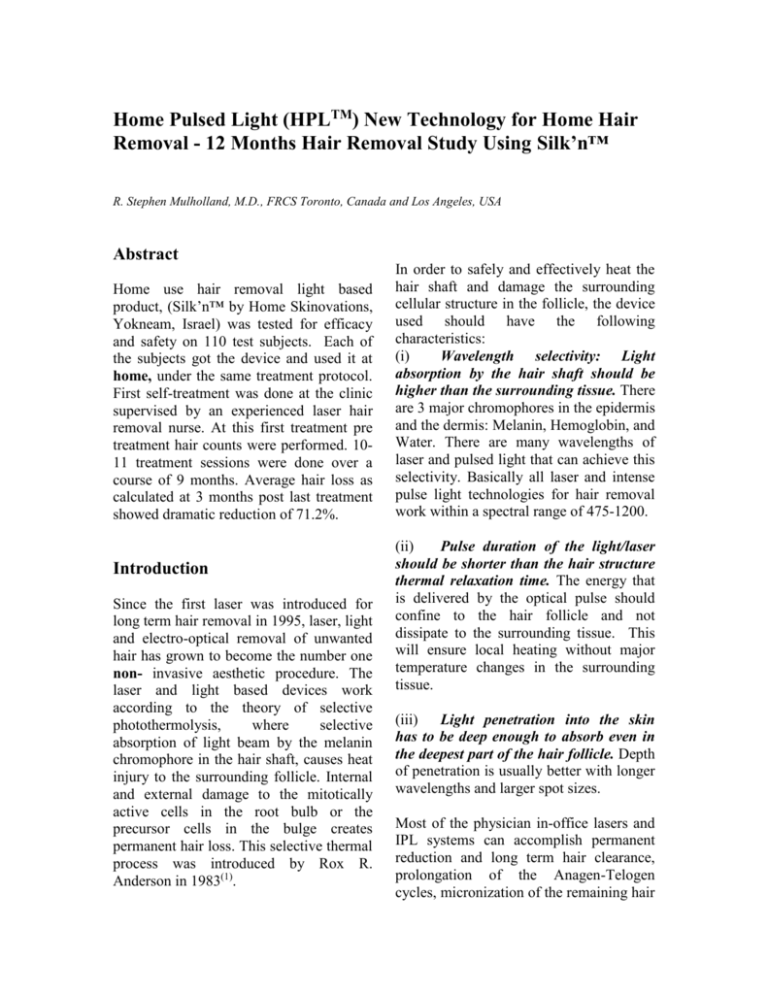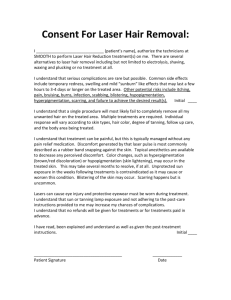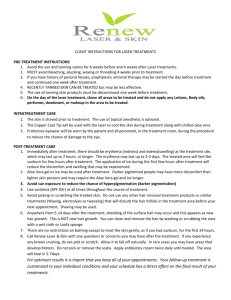Home Pulsed Light (HPLTM) New Technology for Home Hair
advertisement

Home Pulsed Light (HPLTM) New Technology for Home Hair Removal - 12 Months Hair Removal Study Using Silk’n™ R. Stephen Mulholland, M.D., FRCS Toronto, Canada and Los Angeles, USA Abstract Home use hair removal light based product, (Silk’n™ by Home Skinovations, Yokneam, Israel) was tested for efficacy and safety on 110 test subjects. Each of the subjects got the device and used it at home, under the same treatment protocol. First self-treatment was done at the clinic supervised by an experienced laser hair removal nurse. At this first treatment pre treatment hair counts were performed. 1011 treatment sessions were done over a course of 9 months. Average hair loss as calculated at 3 months post last treatment showed dramatic reduction of 71.2%. Introduction Since the first laser was introduced for long term hair removal in 1995, laser, light and electro-optical removal of unwanted hair has grown to become the number one non- invasive aesthetic procedure. The laser and light based devices work according to the theory of selective photothermolysis, where selective absorption of light beam by the melanin chromophore in the hair shaft, causes heat injury to the surrounding follicle. Internal and external damage to the mitotically active cells in the root bulb or the precursor cells in the bulge creates permanent hair loss. This selective thermal process was introduced by Rox R. Anderson in 1983(1). In order to safely and effectively heat the hair shaft and damage the surrounding cellular structure in the follicle, the device used should have the following characteristics: (i) Wavelength selectivity: Light absorption by the hair shaft should be higher than the surrounding tissue. There are 3 major chromophores in the epidermis and the dermis: Melanin, Hemoglobin, and Water. There are many wavelengths of laser and pulsed light that can achieve this selectivity. Basically all laser and intense pulse light technologies for hair removal work within a spectral range of 475-1200. (ii) Pulse duration of the light/laser should be shorter than the hair structure thermal relaxation time. The energy that is delivered by the optical pulse should confine to the hair follicle and not dissipate to the surrounding tissue. This will ensure local heating without major temperature changes in the surrounding tissue. (iii) Light penetration into the skin has to be deep enough to absorb even in the deepest part of the hair follicle. Depth of penetration is usually better with longer wavelengths and larger spot sizes. Most of the physician in-office lasers and IPL systems can accomplish permanent reduction and long term hair clearance, prolongation of the Anagen-Telogen cycles, micronization of the remaining hair follicles and synchronization of the growth cycles(2-4). The laser/light based systems deploy energy densities of 20-120 J/cm2, depending upon the wavelength of light and skin type of the patient. Treatment protocols involve 6-12 treatments over many months and the cost can vary between $75 on the low end per treatment for a small zone up to $1,000 to $1,500 per treatment for large zones. Across the spectrum of companies, devices, wavelengths and fluences, the permanent reduction data ranges between 60-75% reduction after a series of treatments (6-8). The disadvantages of in-office based laser/light hair removal are availability: inconvenience of travel to the clinic for multiple sessions, cost of the treatments, discomfort with the high fluence devices, and risks of pigmentation issues and scars. Using a small low energy Home use system can resolve many of the disadvantages associated with in-office physician laser hair removal treatments. Study Objective The objective of this study was to assess the clinical efficacy, safety and patient tolerance for a low energy, light weight, portable home pulsed light hair removal system (Silk’n™, Home Skinovations, Yokneam, Israel). Materials and Methods 110 female subjects with average age of 32.4 yrs old enrolled to the study. All subjects were trained and performed the first treatment at the investigators office under the supervision of a trained laser nurse. Most common treatment sites were the Bikini (98), Axilla (79), Lower legs (85) Arms (38). Skin types ranged from type Fitzpatrick 1 (3), skin type 2 (43), skin type 3 (47) and skin type 4 (17). Informed Consent was obtained by all study participants. The body sites that were to undergo the hair removal treatment were photographed. Standardized close up photographs were taken pre-treatment, and at the 12 months follow up session treatment. Hair count was preformed on 1 square inch from the before and after pictures. The protocol called for treatment to be done every two weeks for initial 3-4 sessions and then followed by 7 treatments, one month apart. 12 month follow up session took place 3 months after the 10th-11th treatment, where final photography and hair counts were conducted. HPLTM Technology To safely achieve the desired clinical results, the hair shaft needs to selectively absorb HPL™ light energy and transform it into heat. Melanin is the pigment in the hair shaft that is responsible for the absorption of light, which generates the heat at the follicle. Selectivity is achieved when the HPL™ optical energy delivered to the tissue is mostly absorbed by pigment in the hair shaft, while the epidermis and the surrounding tissue remain cool. Additionally HPL™ technology creates an acoustic effect that enhances the overall hair removal effect. Together the optical and acoustic effects of HPL™ technology are what enable Silk’n™ to be safely used by individuals for home based hair removal. The Silk’n deploys energy density of only 10% of the density deployed by IPL/lasers currently on the market: up to 4J/cm2. This low energy can’t create complication and therefore is very safe to the user skin. As a result, the potential risk using the system is minimal. Efficacy is achieved with the additional acoustic effect that contributes vibration to the shaft in a completely safe way. The combination of the low light energy with the acoustic effect of the Silk’n is the safest and most effective way for hair removal using a light based device at home. Before Silk'n™ Treatment During Silk'n™ Pulse level as long as no side effects were noted. The skin of the treatment site was treated with approximately 10% overlap of the Silk’n applicator and without the use of topical gel of any kind. The patients did not use topical anesthetic cream during the study. Following the 10th-11th session patients were followed up after additional 3 months and standardized, close up photography was performed. All photographs were then submitted to a dermatologist observer, experienced in laser hair removal treatments, who calculated the hair density for each of the two regions, treated and untreated in each photograph. The observer was blinded to which zone in each photograph had been treated with the Silk’n device. After Silk'n™ Treatment The Silk’n™ Device Specifications The Silk’n device is a small, portable, low cost, low energy HPL™ (Home Pulsed Light™) system (Figure 1) with the following specifications: Wavelengths: 475nm-1200nm Max energy density: 5 J/cm2 Spot Size: 20 X 30 mm2 Pulse Rate: 1 pulse every 3.5 seconds Silk’n Treatment Technique and Protocol The protocol involved 10-11 HPL treatment sessions. Prior to each session hairs in the treated area were trimmed to a 1-2mm length. The Silk’n hair removal device was then applied to the entire treatment region. Energy level for all patients was set to level 1 at the first treatment and with each follow up treatment was increased by one Figure 1. Silk’n Home Pulsed Light Hair Removal Device Results Complications The device was simple to operate and ergonomically efficient. The patients perceived some very slight discomfort on emission of the light pulse, but none requested the treatment to be stopped nor asked for topical anesthetic cream. There were no complications in the study. Twenty-five percent (25%) of the study patients had peri-follicular erythema that resolved after one hour. Immediate Response The immediate cutaneous response from the Silk’n device was a mild peri-shaft erythema and perifollicular edema that appeared within 5-10 minutes. There was an immediate carbonization of the hair shaft and the aroma of thermal hair shaft coagulation. Hair Clearance success Hair clearances were calculated as the ratio between the hair count at the baseline taken before any treatment and the count taken at each follow up visit. The overall hair reduction average was 71.2% for all patients in all areas. Table 1 shows hair reduction by treatment sites. # of Subjects Bikini line Axilla Lower legs Arms 98 79 85 38 Hair clearance % 68.6 65.3 78.5 73.8 Table 1 Hair clearance by treatment site All of study subjects experienced hair clearance at the 12 months follow up session. Figure 2 shows typical Silk’n Hair removal results in the Axilla, demonstrating dramatic reduction of 90% in hair count. Discussion The worldwide hair removal industry is estimated to be approximately US$ 8.6 billion. The vast majority of hair removal is performed with razors and depilatories with no long term clearance achieved. Electrolysis had formerly been the gold standard of long term hair removal clearance until the arrival of medical grade high fluence lasers and Intense Pulsed Light systems. The worldwide in-office medical laser hair removal industry is currently estimated at US$ 2.9 billion dollars per year, is reasonably expensive but offers a good retail proposition of permanent reduction and long term hair clearance for large, medium and small hair zones. The Silk’n system is the first low cost, light weight, portable and clinically effective pulsed light hair removal system developed. It has proven to be clinically effective at achieving long term hair clearance, is easy to use, fast and safe, with no long term complications observed. Conclusions We have demonstrated in a large, randomized, blinded study the clinical efficacy and safety of the Silk’n Hair Removal Device. The Silk’n device was able to produce hair clearance results that rival in-office, high fluence, physician controlled “big box” laser hair removal devices. The Silk’n device proved to be not only effective, but safe and relatively painless. The only post-treatment reaction that was observed in 25% of the patients was a peri-follicular erythema and edema that was self resolved within one hour. The efficacy, safety profile, comfort, portability and ease of use of the device confirms the clinical and commercial viability of Home Pulsed Light hair removal, that is expected to alter how hair removal is conducted. References 1. 2. Anderson R. R., Parrish J.A. Selective photohermolysis: Precise microsurgery by selective absorption of pulseRadiation, Science 220:524, 1983 Grossman M.C., Dierickx C, Farinelli W, Flotte T, Anderson R. Damage to hair follicles by normal 3. 4. 5. mode ruby laser pulses. J Am Acad Dermatology 1996, 35:889-894. Lou, W.W, Quintana, R.G., Geroneumus, M.C., Grossman M.C. Prospective study of hair reduction by diode laser (800nm) with long term follow up. Derm Surgery 2000, 26:428-432. Goldberg, D.J., Marmur E.S. and Hussain, M. Journal of Cosmetic and Laser Therapy. 7(1): 2528, 2005 Medical Insight, Inc., 2005.








